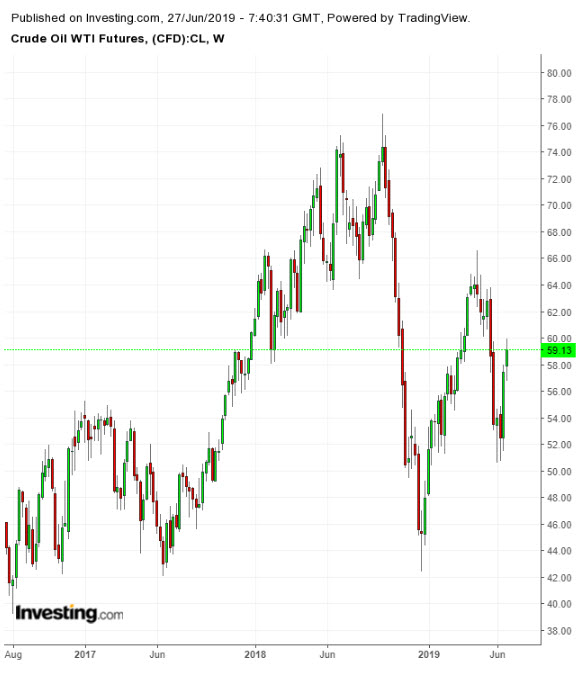In the first half of 2019, the movement in oil markets and trader concerns were dominated by sanctions on Iran’s oil industry, rising tensions in the Persian Gulf and various indicators of a potential global economic slowdown.

As we look forward to the second half of 2019, here are three key oil market drivers that traders should be watching.
1. Trade Talks Between U.S. And China
This is probably the single largest catalyst of price movement right now and could have a significant impact on market sentiment and outlook. Any hint of improving or worsening trade relations between the U.S. and China has the potential to move the direction of oil prices. Presidents Trump and Xi will be meeting immediately following the G20 gathering in Japan at the end of this week. Traders should not expect any resolution to come from this meeting, but the tone and outcome will be an important signal for global economic sentiment and oil demand outlook. The best we can probably hope for is a commitment for further negotiations in the coming months and positive statements about removing current tariffs or, at least, holding off on additional tariffs. Of course, if China and the U.S. reach an agreement on trade at any point during the rest of 2019, we can expect oil prices to increase, as this will be seen as a positive sign for the global economy and oil demand.
2. U.S. Crude Oil Production And Exports
As yesterday’s EIA data revealed, the U.S. oil industry remains a major driver of prices. American production is strong and if this creates a build-up in storage tanks, prices will trend lower. However, the U.S. is finally starting to see the needed improvements in oil infrastructure—such as pipelines—come online this summer. As more oil is able to efficiently flow from the wellhead to refineries and export terminals, we are less likely to see buildups and bottlenecks in storage. Yesterday’s EIA report, which showed a record 9.4 million barrels per day of exports and a 12.8 million barrel inventory draw, reflected this. Oil prices reacted positively to this news, although some of that upward price movement was the result of very positive statements from U.S. Treasury Secretary Mnuchin about the potential for resuming trade negotiations with China.
The one dark cloud in the EIA report is that refinery utilization is still relatively weak compared to earlier. This will be a key indicator for traders to watch in the second half of 2019. If American refineries aren’t operating at full capacity, it either means that the refineries expect the demand for products to weaken or they aren’t able to obtain sufficient supplies of the types of oil necessary to make the products in demand at the right prices.
The recent fire at the Philadelphia refinery and the subsequent decision to close the facility creates its own demand issue in the U.S. since the 335,000 barrels of crude oil that were being processed there per day are no longer in use. That oil could now be sold to other refineries, exported or stored. The question is how much other refineries will be able to make up the demand with the increase of their own processing. The refinery shutdown was announced on Tuesday at the same time as good news for WTI (EIA numbers and China news), so its impact on oil prices was not seen and may only have an effect when new supply and demand numbers are published.
3. OPEC And OPEC+
The upcoming OPEC meeting, which will take place on the 1st and 2nd of July, should indicate what we can expect from many of the world’s largest oil producers in the second half of 2019. U.S. sanctions on Venezuela and Iran have pushed OPEC’s total production down significantly more than OPEC’s own production cuts, but much still depends on OPEC’s other big producers—Saudi Arabia and Iraq.
Saudi Arabia is still producing below its quota, but may increase production in the second half of the year. The Saudi national oil company, Aramco, recently inked a deal to provide more crude oil to South Korean refiners and is looking to expand its operations in India. If Saudi Arabia increases production and exports to satisfy these customers, oil prices may fall. But as the summer ends, Saudi Arabia’s domestic oil consumption will decrease significantly making more oil available for export.
Iraq, on the other hand, continues to produce above its quota and is actively looking to increase production. Even if OPEC reaches a consensus to continue with the current agreement, traders should keep a close eye on production from Iraq. Iraq will use any opportunity it has to produce and export more barrels. Saudi Arabia should also be watched, as it can increase its exports at will if the financial incentive is there.
On the OPEC+ front, Russia seems eager to roll over the current deal now, particularly because it was recently forced to decrease its own production due to contamination in a major pipeline. The contamination problem was supposed to be resolved weeks ago, but it is still ongoing. Once the problem is settled, Russia will be looking for any avenue to increase output, even in contravention of the OPEC+ deal. Russia is typically not shy about violating production agreements. For example, before the contamination problem, Russia was on pace to overproduce in this period by huge amounts. Higher production from Russia could also push prices lower in the second half of the year.
